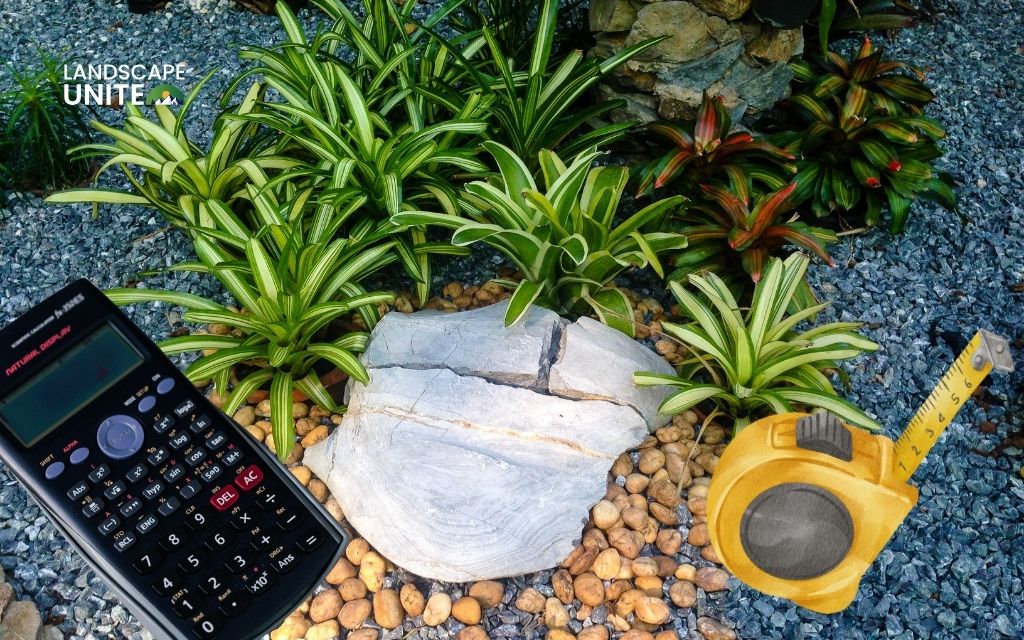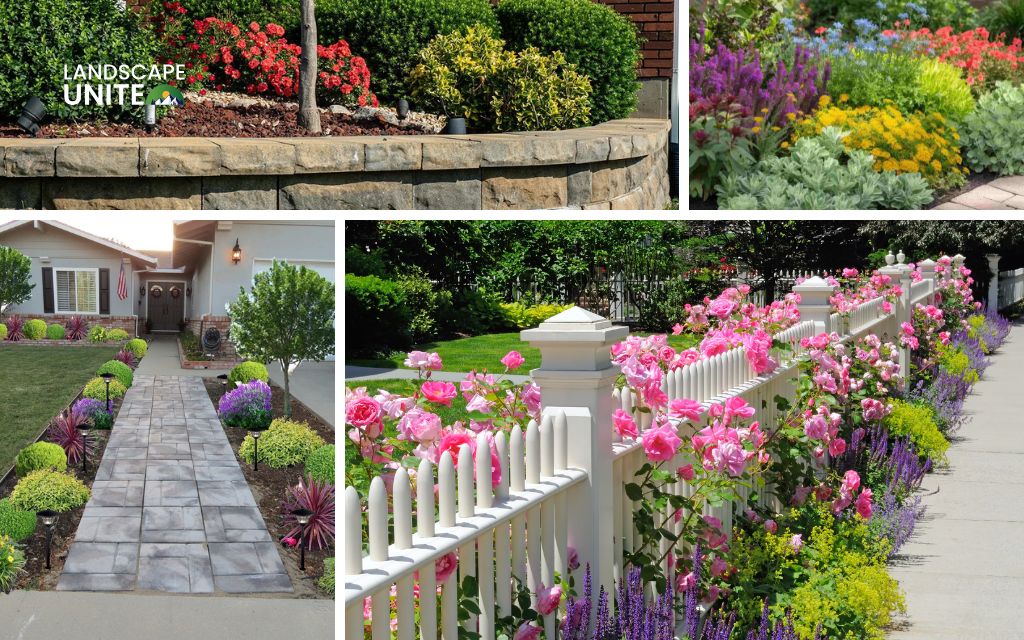Plant diseases can turn your thriving garden into a disappointing mess faster than you’d expect. Have you ever watched helplessly as powdery mildew spread across your roses or blight destroyed your tomato plants? Choosing the right fungicides for plants makes all the difference between a flourishing garden and complete devastation.
This comprehensive guide walks you through the most effective fungicide options available, from organic copper-based solutions to advanced systemic treatments that work from within. You’ll discover proper application timing, essential safety protocols, and exactly how to select the perfect fungicide for your specific garden needs. Whether you’re protecting delicate flower beds or keeping your vegetable garden healthy and productive, these proven strategies help you maintain beautiful, disease-free plants while staying environmentally responsible.
Understanding different types of fungicides
Contact fungicides: Surface protection
Contact fungicides work by creating a protective barrier on plant surfaces. When you apply these products, they stay exactly where they land and prevent fungal spores from germinating. Think of them as a shield that guards your plants against invading pathogens. These fungicides for plants need reapplication after rain or heavy watering because they don’t move within the plant tissue.
The most popular contact fungicides include chlorothalonil and mancozeb, which is often called the “King of Fungicides” due to its broad-spectrum effectiveness against numerous plant diseases. You’ll find contact fungicides particularly useful for preventing powdery mildew, leaf spot, and rust on ornamental plants. They work best when applied before disease symptoms appear or at the very first signs of infection.
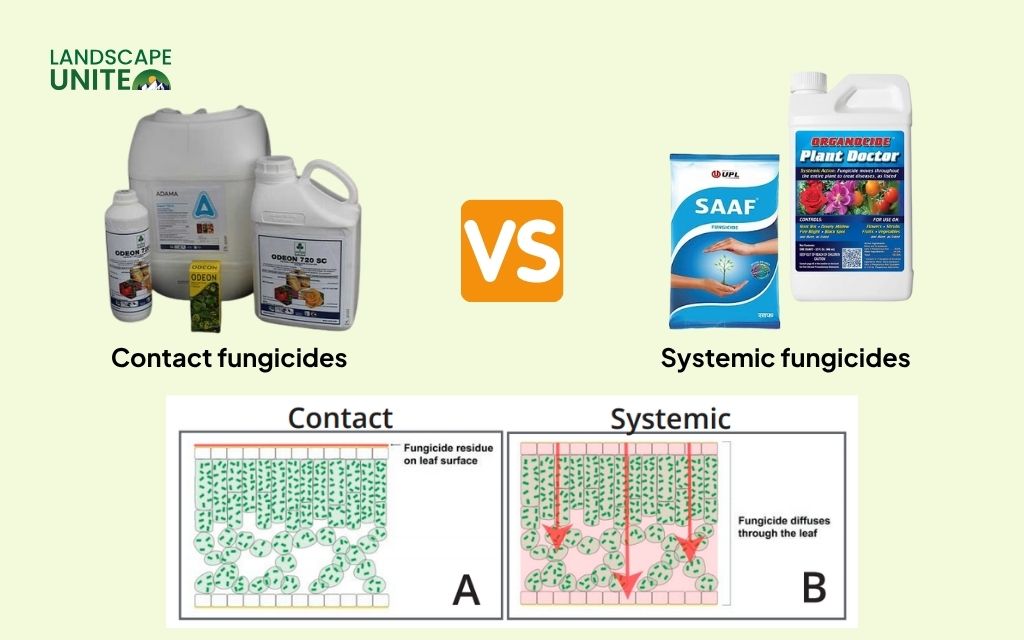
Systemic fungicides: Internal plant defense
Systemic fungicides offer a completely different approach to disease control. Once absorbed, these products move through your plant’s vascular system, providing protection from the inside out. This internal defense mechanism means systemic fungicides can actually cure existing infections, not just prevent new ones.
Products containing propiconazole, tebuconazole, or azoxystrobin represent modern systemic options that experienced gardeners rely on. What makes systemic fungicides truly remarkable is their anti-sporulant activity, which prevents disease spread even after infection has begun. They also last longer between applications since rain doesn’t wash them off plant surfaces. Some systemic fungicides can even improve plant stress tolerance beyond their disease control benefits.
Organic vs synthetic options
Should you choose organic or synthetic fungicides? The answer depends on your gardening philosophy and specific needs. Here’s a quick comparison to help you decide:
| Feature | Organic Fungicides | Synthetic Fungicides |
| Active Ingredients | Naturally-derived (copper sulfate, neem oil, Bacillus subtilis, Trichoderma) | Chemically synthesized compounds |
| Application Frequency | Every 5-7 days, more frequent | Every 10-14 days, less frequent |
| Rain Resistance | Lower, requires reapplication | Higher, longer-lasting protection |
| Environmental Impact | Minimal, biodegradable | May have restrictions, slower breakdown |
| Effectiveness | Good for prevention, requires consistency | Excellent for prevention and cure |
| Soil Benefits | Can enhance beneficial microbiome diversity | No soil enhancement benefits |
| Cost per Application | Lower individual cost | Higher individual cost, fewer applications needed |
| Food Crop Safety | Generally shorter wait times | Longer pre-harvest intervals required |
Many successful gardeners use both types strategically, applying organic solutions for routine prevention and reserving synthetic products for serious disease outbreaks.
3 Best fungicides for specific garden areas
1. Fungicide for flower beds: Ornamental protection
Your fungicide for flower beds needs differ from other garden areas. Ornamental plants face unique disease pressures that require specialized treatment approaches.
Common flower bed diseases:
- Black spot (especially on roses)
- Powdery mildew
- Botrytis blight
- Rust on flowering plants
Best products for flower beds:
- Garden Safe: Organic options for eco-conscious gardeners
- Bayer: Synthetic formulations for stubborn problems
- Spectracide: Ready-to-use sprays for quick application
Key benefits of flower bed fungicides:
- Protect blooms without visible residue
- Keep flowers looking beautiful and healthy
- Prevent disease before it starts
- Safe for use around ornamental plantings
Application tips:
- Use ready-to-use sprays for small beds and containers
- Apply weekly during humid weather
- Treat preventively before symptoms appear
- Focus on new growth and developing buds
2. Fungicide for vegetable garden: Edible crop safety
Selecting a fungicide for vegetable garden requires extra caution. You’ll eventually eat these plants, so safety comes first.
Critical safety checks:
- Always verify product is labeled for your specific vegetables
- Check pre-harvest intervals (days between application and harvest)
- Never exceed recommended application rates
- Wash produce thoroughly before consuming
3 Best fungicides for specific garden areas
Copper-based products control:
- Late blight on tomatoes
- Downy mildew on cucumbers
- Anthracnose on beans
- Various bacterial diseases
Biological fungicides offer:
- Beneficial microorganisms
- Safe for edible crops
- No harmful chemical residues
- Environmental protection
Application schedule for vegetables:
- Copper fungicides: Every 7-10 days during active disease periods
- Biological products: Every 5-7 days for best results
- After rain: Reapply contact fungicides immediately
Smart vegetable garden practices:
- Rotate between different fungicide types
- Prevent pathogen resistance development
- Use products specifically labeled for vegetables
- Maintain food safety while controlling disease
3. Fungicide for bushes and shrubs
Woody plants like bushes and shrubs need different protection strategies. They face unique disease challenges that require specialized treatment.
Common shrub diseases:
- Stem canker
- Rust diseases
- Various leaf spots
- Overwintering fungal pathogens
Two application methods for woody plants:
Method 1: Trunk injection systems (innovative approach)
- Delivers fungicides directly into vascular system
- Provides months of protection from single treatment
- Perfect for valuable landscape specimens
- Eliminates need for repeated spraying
Method 2: Traditional foliar sprays
- Apply in early spring before new growth
- Treat again in fall before dormancy
- Protects against overwintering pathogens
- Cost-effective for multiple shrubs
Benefits of proper shrub treatment:
- Season-long disease protection
- Penetrates woody tissue effectively
- Reduces maintenance requirements
- Keeps landscape looking professional
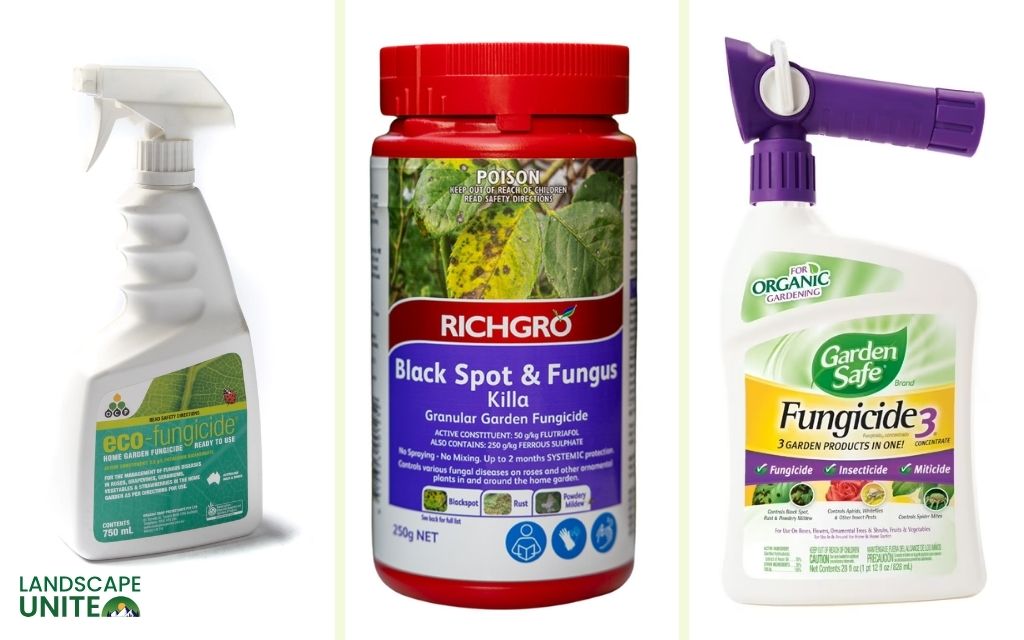
Soil treatment applications
Sometimes disease problems start underground, requiring fungicide for plants soil applications rather than foliar sprays. Root rot, damping-off disease, and various soil-borne pathogens destroy plants from the roots up. Soil drench applications deliver fungicides directly to the root zone where these diseases develop.
Products containing mefenoxam or fosetyl-aluminum work exceptionally well as soil treatments. Mix these concentrates according to label directions and apply them around the plant base, allowing the solution to soak into the root zone. Certain organic fungicides can enhance beneficial soil microbiome diversity while controlling harmful pathogens, creating a healthier growing environment for all your plants.
Top-rated fungicides by 9 disease types
Matching the right fungicide to your specific disease problem ensures the best results. Here’s your quick reference guide:
| Disease Type | Recommended Fungicide Type | Active Ingredients | Application Timing |
| Powdery Mildew | Contact or Systemic | Myclobutanil, sulfur, neem oil | At first white patches, weekly |
| Black Spot (Roses) | Systemic preferred | Propiconazole, tebuconazole | Early spring, every 7-14 days |
| Late Blight | Contact preventive | Chlorothalonil, copper | Before symptoms, weekly in wet weather |
| Early Blight | Contact | Chlorothalonil, mancozeb | When plants flower, every 7-10 days |
| Root Rot | Systemic soil drench | Oxathiapiprolin, mefenoxam | At first wilting signs |
| Rust Diseases | Contact or systemic | Propiconazole, sulfur | Early season, every 10-14 days |
| Botrytis Blight | Systemic | Azoxystrobin | During bloom period, every 7-10 days |
| Anthracnose | Contact | Copper, chlorothalonil | Preventive, every 7-14 days |
| Downy Mildew | Systemic | Fosetyl-aluminum | Before symptoms, every 7-10 days |
Powdery mildew control solutions
Powdery mildew creates that distinctive white, dusty coating on leaves, stems, and sometimes flowers. This common fungal disease thrives in warm, dry conditions with cool nights. Your garden fungicide spray for powdery mildew should contain active ingredients like myclobutanil or sulfur.
Natural fungicide recipes for powdery mildew include baking soda solutions (one tablespoon per gallon of water with a few drops of dish soap). While homemade treatments work for light infestations, commercial products deliver more reliable control. Apply treatments at the first sign of white patches, covering both upper and lower leaf surfaces thoroughly. Weekly applications throughout the growing season keep this persistent disease under control.
Black spot and leaf spot treatments
Black spot on roses and various leaf spot diseases on other ornamentals respond well to targeted fungicide applications. The best fungicide for black spot on roses contains active ingredients like propiconazole or tebuconazole, which provide both preventive and curative action.
Start your treatment program early in spring when new growth begins. Black spot spreads rapidly during wet weather, so increase application frequency during rainy periods. Remove and destroy infected leaves to reduce disease pressure, then apply fungicides to remaining healthy foliage. This integrated approach combining sanitation and chemical control delivers the best results.
Blight prevention strategies
Late blight devastated the Irish potato crop in the 1840s, and this disease still threatens tomatoes and potatoes today. Preventive fungicide spray schedules for vegetables should begin when plants start flowering or when weather conditions favor disease development (cool, wet weather).
Chlorothalonil provides excellent preventive control of early and late blight. Apply this contact fungicide weekly during favorable disease conditions. For organic gardeners, copper fungicides offer effective blight prevention when applied before symptoms appear. The key to blight management is timing. Once this aggressive disease establishes, it spreads incredibly fast and becomes much harder to control.
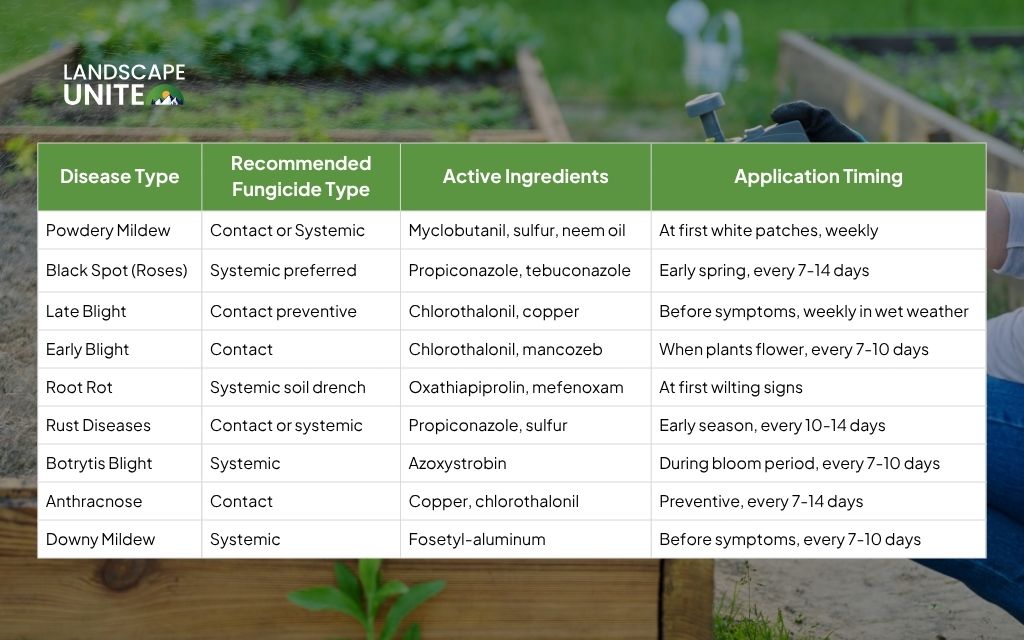
Root rot management
Root rot diseases prove challenging because symptoms appear above ground while the problem develops below. Fusarium, Pythium, and Phytophthora species cause most root rot problems in gardens. The breakthrough fungicide oxathiapiprolin specifically targets oomycete pathogens like Phytophthora, representing a new mode of action in disease control.
Apply root rot fungicides as soil drenches at the first sign of wilting or yellowing plants that don’t respond to watering. Improving drainage and avoiding overwatering prevents many root rot problems before they start. Combining cultural practices with targeted fungicide applications gives your plants the best chance of survival.
Application guidelines and best practices
Timing your fungicide applications
When should you apply fungicide to your plants? Timing makes the difference between success and failure. Most diseases spread most rapidly during warm, humid conditions. Apply fungicides preventively before disease symptoms appear or at the very first signs of infection for best results.
Here’s your application frequency guide:
| Fungicide Type | Standard Frequency | Rainy Weather | Dry Weather | After Rain |
| Contact (Organic) | Every 5-7 days | Every 5 days | Every 7-10 days | Reapply immediately |
| Contact (Synthetic) | Every 7-10 days | Every 7 days | Every 10-14 days | Reapply within 24 hours |
| Systemic | Every 10-14 days | Every 10 days | Every 14-21 days | No immediate reapplication needed |
| Biological | Every 5-7 days | Every 5 days | Every 7 days | Reapply within 24 hours |
| Soil Drench | Every 14-21 days | Every 14 days | Every 21-28 days | Not affected by rain |
The best time of day to apply fungicide is early morning or late evening when temperatures are cooler and humidity is higher. Avoid midday applications during hot weather, which can stress plants and reduce fungicide effectiveness. Wind can also interfere with proper coverage, so choose calm days for spraying.
Proper mixing and spray techniques
How do you apply systemic fungicide to flower beds effectively? Follow these steps for optimal results:
- Read the product label completely before starting any application
- Calculate the exact amount needed based on your garden area
- Measure concentrate carefully using proper measuring tools, never estimate
- Fill sprayer halfway with water before adding any concentrate
- Add the measured fungicide to the water in your sprayer
- Fill sprayer to final volume with remaining water
- Agitate thoroughly by shaking or stirring for even distribution
- Test spray pattern on pavement before treating plants
- Apply to all plant surfaces including undersides of leaves
- Spray until point of runoff when liquid just begins dripping from leaves
- Clean equipment immediately after use with soap and water
- Store remaining product in original container in cool, dry location
Complete coverage of all plant surfaces, including undersides of leaves where many fungal spores germinate, ensures maximum protection. Use appropriate spray equipment for your garden size. Small gardens work fine with handheld spray bottles, while larger areas benefit from pump sprayers or hose-end applicators.
Copper fungicide application timing for fruit trees follows specific seasonal schedules. Apply dormant sprays before buds break in spring, then follow with regular applications during the growing season according to your specific disease concerns. Understanding these timing windows optimizes disease control while minimizing unnecessary applications.
Safety protocols and environmental considerations
Protecting yourself and the environment requires following proper safety procedures. Here’s your essential safety checklist:
- Always wear protective equipment: gloves, long sleeves, long pants, and eye protection
- Mix fungicides outdoors or in well-ventilated areas only
- Never eat, drink, or smoke while handling fungicides
- Keep children and pets away from treatment areas until spray dries
- Store products in original containers with labels intact
- Keep fungicides away from food and food preparation areas
- Wash hands and exposed skin thoroughly after application
- Wash contaminated clothing separately from regular laundry
- Dispose of empty containers according to label directions
- Never pour excess fungicide down drains or into water sources
Environmental stewardship matters when using fungicides for plants. Apply products only when needed rather than following rigid calendar schedules. Spot-treat affected areas instead of spraying entire gardens unnecessarily. Choose organic options when they provide adequate control to minimize environmental impact. Never apply fungicides near water sources like ponds, streams, or storm drains where runoff could contaminate aquatic ecosystems.
Organic fungicide alternatives
Copper-based fungicides
Copper sulfate and other copper-based fungicides have protected plants for over a century. These proven organic options control bacterial diseases in addition to many fungal pathogens. Bonide Copper Fungicide spray provides ready-to-use convenience, while concentrated formulations allow professional-level applications.
Apply copper products preventively before disease pressure builds. They work through contact action, so thorough coverage of all plant surfaces matters. Copper can accumulate in soil over time, so rotate with other fungicide types and avoid excessive applications. Despite this consideration, copper remains among the most reliable organic disease control tools available.
Biological control agents
Living microorganisms offer fascinating alternatives to chemical fungicides. Products containing Bacillus subtilis colonize plant surfaces and compete with disease-causing fungi for space and nutrients. Trichoderma species not only control diseases but can also enhance beneficial soil microbiome diversity, creating healthier growing conditions.
These biological fungicides work best when applied preventively. The beneficial organisms need time to establish before disease pathogens arrive. Apply biological products during favorable conditions (moderate temperatures and adequate moisture) that support microbial activity. While they typically require more frequent applications than synthetic fungicides, biological options offer excellent safety profiles for gardens where children and pets play.
Homemade fungicide recipes
Can you make effective fungicides at home? Simple recipes using common household ingredients provide options for minor disease problems. Here are three proven recipes:
Baking Soda Spray:
- 1 tablespoon baking soda
- 1 tablespoon horticultural oil
- 1 tablespoon dish soap
- 1 gallon water
- Mix thoroughly and spray weekly
Milk Spray for Powdery Mildew:
- 1 part milk (any type)
- 9 parts water
- Mix and apply twice weekly
Garlic Fungicide:
- 2 whole garlic bulbs, minced
- 1 quart water
- Let steep 24 hours, strain, and spray
While homemade treatments won’t replace commercial products for serious disease problems, they provide economical options for light infestations and preventive care.
Need help with persistent disease problems? Discover more organic gardening solutions on our blog, or contact professional gardeners at Mile High Lifescape for expert diagnosis and treatment recommendations tailored to your specific situation.
Fungicide resistance management
Rotation strategies
Can plants develop fungicide resistance? Actually, the fungi develop resistance when exposed repeatedly to the same products. This serious problem threatens long-term disease control effectiveness. Fungicide resistance management for home gardens requires strategic rotation between different chemical classes.
Check product labels for FRAC (Fungicide Resistance Action Committee) codes, which indicate the mode of action. Rotate between products with different FRAC codes rather than simply switching brands that might contain the same active ingredients. For example, alternate between contact fungicides like chlorothalonil and systemic products like propiconazole throughout the growing season.
Warning signs your plants may have developed fungicide resistance:
- Disease continues spreading despite proper application timing and coverage
- Previously effective products no longer control diseases adequately
- Disease symptoms appear worse after treatment than before
- Only partial control achieved instead of complete disease suppression
- Resistance develops in just one or two seasons of repeated use
- Other gardens in your area report similar failures with same products
If you suspect resistance, switch to a completely different fungicide class and improve cultural practices to reduce disease pressure.
Integrated disease management
The most successful gardeners never rely solely on fungicides. Integrated pest management (IPM) combines multiple strategies for comprehensive disease control. Proper plant spacing improves air circulation, reducing humidity that favors fungal growth. Remove and destroy diseased plant material promptly to eliminate sources of new infections.
Choose disease-resistant plant varieties whenever possible. Water early in the day so foliage dries before evening. Avoid overhead watering that keeps leaves wet for extended periods. Maintain soil health through organic matter additions, which support beneficial microorganisms that naturally suppress plant pathogens. These cultural practices reduce your dependence on fungicides while creating healthier gardens overall.
Seasonal fungicide calendar
Planning your fungicide applications by season ensures you’re always one step ahead of disease problems. Here’s your year-round guide:
| Season | Primary Tasks | Fungicide Types | Target Diseases | Application Frequency |
| Spring (March-May) | Preventive protection for new growth | Copper, chlorothalonil, systemic | Black spot, powdery mildew, leaf spots | Every 7-14 days |
| Early Spring | Dormant sprays before bud break | Copper sulfate, lime sulfur | Overwintering pathogens | One application |
| Late Spring | Active prevention as plants leaf out | Contact and systemic rotation | Rust, anthracnose, early blight | Weekly during wet weather |
| Summer (June-August) | Ongoing disease management | All types as needed | Powdery mildew, late blight, leaf spots | Every 7-14 days, increase in humidity |
| Early Summer | Monitor and treat as needed | Organic and synthetic options | Heat-stress related diseases | Every 10-14 days |
| Late Summer | Maintain protection, reduce frequency | Contact fungicides primarily | Powdery mildew, botrytis | Every 10-14 days |
| Fall (September-November) | Break disease cycles, cleanup | Copper, preventive contact | Overwintering spores, leaf spots | Every 14-21 days |
| Early Fall | Protect against cool-weather diseases | Systemic and contact | Downy mildew, rust | Every 14 days |
| Late Fall | Final cleanup applications | Copper sulfate | All overwintering pathogens | One final application |
| Winter (December-February) | Planning and dormant sprays | Dormant oil combinations | Overwintering diseases | One application in late winter |
Spring prevention programs
Spring marks the beginning of active fungal disease seasons. Start your preventive treatment program when plants break dormancy and new growth emerges. This critical timing protects tender young tissues most vulnerable to infection.
Your spring prevention checklist:
- Apply dormant oil sprays combined with copper fungicides to fruit trees and woody ornamentals before buds swell
- Inspect plants weekly for early disease signs once foliage develops
- Remove and destroy any diseased plant material from previous season
- Clean and sanitize pruning tools before starting spring work
- Mulch beds to prevent soil-borne pathogen splash onto foliage
- Begin regular fungicide applications when leaves fully emerge
- Increase monitoring during wet spring weather when diseases spread fastest
Weather-related diseases spread most rapidly during cool, wet spring conditions. Monitor forecasts and increase fungicide application frequency during extended rainy periods. Keep your spray equipment ready because timing matters when trying to stay ahead of disease development.
Summer disease management
Summer’s warm, humid weather creates perfect conditions for many fungal diseases. Powdery mildew, rust, and various leaf spots peak during summer months. Maintain your regular fungicide application schedule, adjusting frequency based on disease pressure and weather patterns.
Plant stress factors like heat and drought can weaken natural disease resistance. Water deeply and consistently to help plants withstand disease pressure. Apply mulch to maintain even soil moisture and reduce stress. Well-maintained plants better tolerate disease and respond more effectively to fungicide treatments.
Fall garden preparation
Fall presents opportunities to break disease cycles before winter. Apply fungicides to plants showing late-season disease symptoms to prevent overwintering of fungal pathogens. Remove and destroy severely infected plant material rather than composting it, which might spread diseases next spring.
Apply final fungicide treatments to perennials and woody plants in late fall after most leaves have dropped. This protects dormant tissues from infection and reduces disease pressure next growing season. Clean and sanitize garden tools, stakes, and trellises that might harbor fungal spores. These fall cleanup activities, combined with strategic fungicide applications, set the stage for healthier gardens next year.
Conclusion
Selecting the right fungicides for plants requires understanding your specific garden needs, disease pressures, and environmental responsibilities. Whether you choose organic copper-based solutions for sustainable vegetable gardening or advanced systemic treatments for stubborn ornamental diseases, consistent application and proper timing ensure optimal plant health. Remember that fungicides work best as part of an integrated approach that includes good cultural practices like proper plant spacing, adequate air circulation, and sanitation measures.
Ready to transform your garden into a disease-free paradise? Take action today:
- Assess your garden’s current disease risks and identify problem areas
- Select appropriate fungicides based on your specific plants and conditions
- Implement a proactive prevention program before diseases establish themselves
- Monitor your plants regularly for early signs of infection
- Rotate between different fungicide types to prevent resistance
Landscape Unite serves as your trusted resource for gardening and landscape expertise, providing practical solutions that create beautiful, healthy outdoor spaces year-round. Contact Landscape Unite for more expert gardening tips and discover our comprehensive collection of plant care guides to answer all your growing questions. Your thriving, disease-free garden awaits.
FAQs about fungicides for plants
How often should I apply fungicide to my plants?
Most fungicides require application every seven to fourteen days during active growing season, with frequency adjusted based on weather conditions and disease pressure. Rain washes off contact fungicides, requiring reapplication. For specific timing recommendations tailored to your plants and region, explore our detailed guides or consult professional gardeners who understand your local disease patterns.
Can I use the same fungicide on vegetables and ornamental plants?
While many fungicides are labeled for both vegetable and ornamental use, always check the specific product label for approved crops and pre-harvest intervals for edible plants. Different products have different safety profiles. When in doubt about product selection, read our vegetable garden guides or reach out to Mile High Lifescape for personalized recommendations.
What’s the difference between organic and synthetic fungicides?
Organic fungicides use naturally-derived active ingredients like copper sulfate or beneficial microorganisms and typically require more frequent applications. Synthetic fungicides often provide longer-lasting protection but may have environmental restrictions. Both types offer effective disease control when used properly.
When is the best time of day to apply fungicide?
Apply fungicides in early morning or late evening when temperatures are cooler and humidity is higher. Avoid midday heat that can stress plants and reduce treatment effectiveness. Calm weather conditions ensure better spray coverage.
How do I know if my plants have developed fungicide resistance?
Signs include continued disease progression despite proper application, reduced treatment effectiveness over time, and failure of previously successful products to control diseases. Combat resistance by rotating between different fungicide classes (FRAC codes) and improving cultural practices.
